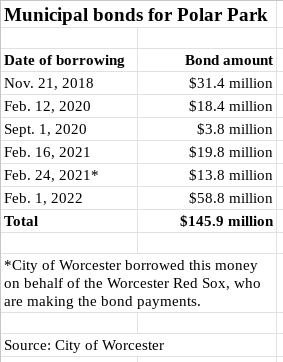Despite anticipated revenue shortfalls, the City of Worcester projects to continue making the debt payments on the $160-million Polar Park baseball stadium, as promised, without tapping general taxpayer funds.
As was the case for the first two years of debt payments, the saving grace for the current fiscal year 2023 and the next fiscal year 2024 is a $3-million property sale from 2021, the proceeds of which were placed into a reserve fund to help make the Polar Park payments.

Those reserve funds will be nearly depleted by the end of fiscal 2024, but by that time, the City anticipates the special district improvement financing (DIF) area around the ballpark will become revenue positive, particularly as more proposed housing, hotel, and office developments in the DIF come online. If those revenue-positive years start adding up, the City projects the DIF will generate at least $50 million in excess funding, above what is needed for the debt payments, over the 30-year lifespan of the DIF.
“The ballpark, it is successful,” Worcester City Manager Eric Batista said. “It continues to pay for itself, and it is attracting developments to the neighborhood and bringing attention to the city.”
Four years of shortfalls

In order to acquire the land, build the ballpark, and make other improvements to the Canal District neighborhood like street and sidewalk upgrades, the City of Worcester from 2018-2022 borrowed a total of $146 million through six long-term municipal bonds, according to a presentation Batista made to the Worcester City Council’s Standing Committee on Finance on Tuesday night. When the ballpark was initially proposed in 2018 as a publicly-owned home for the relocating Pawtucket Red Sox minor league baseball team, the City planned for the revenues from inside the DIF to cover the annual debt payments on the bonds. Then City Manager Edward Augustus repeatedly called this pay-for-itself promise his North Star for the stadium project, a mantra Batista has continued since he took over as city manager in June 2022.
“I don’t want it to be in a place where I’m pulling more revenues from the general budget,” Batista said. “Like with the ballpark, the goal is to create projects that create new revenue for the City.”
The amount of the debt payments vary by year and generally increase annually, including a significant spike in 2049 when the annual payment exceeds $14 million, according to the presentation. The first year the City needed DIF revenues to help cover debt payments was fiscal 2021, and every year since then those DIF revenues have fallen short of what the City needed:
- In fiscal 2021, the DIF revenues were short about $250,000.
- In fiscal 2022, DIF revenues were short $1.3 million.
- In fiscal 2023, which is the current fiscal year ending on June 30, the City projects DIF revenues will be short $1.8 million.
- In fiscal 2024, which starts July 1, the City projects DIF revenues will be short $644,000.
However, those shortfalls have been offset by the City’s DIF reserve fund, which received its most significant contribution in November 2021 when the City sold a publicly-owned property on Green Street for $3 million to the developers of The Cove, a 171-unit, seven-story housing complex now under construction. The City had originally purchased the parcel in anticipation of needing it for Polar Park and then sold it when it wasn’t necessary for the ballpark.

The DIF reserve fund had $2.7 million left at the start of fiscal 2023, and after the projected DIF revenue shortfalls for the two next fiscal years, the City anticipates the fund will have $310,179 left at the end of fiscal 2024, according to Batista’s presentation.
“This is where it gets tightest,” City of Worcester CFO Tim McGourthy said. “2024 is when we get closest to the base of the reserve.”
If the reserve gets so low where the City can’t make the debt payments out of the DIF revenues, Batista would ask the City Council for a special appropriation out of general taxpayer revenues to cover the difference, he said Monday during his weekly appearance on the Radio Worcester show “Talk of the Commonwealth.”

Batista and McGourthy do not anticipate that happening, though, as their projections show the DIF generating more money than necessary within the next few fiscal years.
“We anticipate the DIF will remain cash-flow positive,” McGourthy said.
Ballpark DIF revenues
Revenue in the stadium district comes from a variety of sources, said Batista. The overall cash flow is only marginally tied to the success of the Worcester Red Sox in attracting fans to the Canal District, and those monies – parking fees and taxes on concessions and restaurant meals – make up a small portion of the DIF revenues.
Instead, the DIF cash flow is largely tied to the housing and commercial developments proposed and under construction around the ballpark. When the stadium was proposed in 2018, the sole developments this plan was based upon came from Boston developer Madison Properties, which proposed a $140-million total investment across two hotels, two residential buildings, and two office complexes.
Those Madison developments have since shrunk in size and been delayed, such as the hotel proposal being whittled down to one facility and delayed to 2025. However, new developments have been proposed inside the DIF, including The Cove and the proposed 400-unit, six-building Table Talk Lofts development.
As those developments are finished, the property values rise, and the tax payments start rolling in, the DIF will generate enough revenues to cover the annual debt payments, McGourthy said.
Other DIF revenue sources include the WooSox annual lease payment, ballpark advertising revenue, suite rental, and Madison Properties’ lease for the 340-space parking garage, which is $178,750 annually but includes higher payments in fiscals 2023 and 2024 because of Madison’s use of the garage before the lease officially started.

With all these revenues, the City anticipates the DIF will generate at least $50 million more than necessary for the debt payments over the DIF’s 30-year lifespace, according to Batista’s presentation. Once the City is certain the DIF reserve fund has enough money to cover the annual debt payments, McGourthy said the City can begin to withdraw excess revenue for the General Fund, which covers the expenses for the majority of City services.
The $50-million excess projection is based on a number of assumptions, and Batista said he is concerned about events like an economic recession or another COVID-like pandemic disrupting the City’s plans. The City is being conservative in its revenue projections, he said, to factor in any unknown changes.
“We can’t predict what the future may hold,” Batista said.
Public perception
In May, an academic study used Polar Park as one of two national examples of why the pay-for-itself pro forma was largely a myth, saying governments shouldn’t count on tax revenues from surrounding developments to cover the cost of debt service. The study from professors at the College of the Holy Cross in Worcester and Kennesaw State University in Georgia said Polar Park would run a $40-$60-million deficit over the DIF’s 30-year lifespan.
The study arrived at those figures based on the rise in the construction cost of the stadium from its original $101-million estimate and the delay and shrinking of the Madison Properties developments.
When factoring in the other revenue streams, particularly the tax revenues from the additional developments like The Cover and Table Talk Lofts, the City arrives at its $50-million surplus figure.
Regardless of what happens with the finances, Batista said he plans to make annual updates to the City Council on the DIF revenues for the ballpark, in order to answer the complex questions around its financing, given the high level of public interest in the project.
“There are a number of folks in the community who will be skeptical, and they will always be skeptical,” he said. “We won’t fight it, but we will communicate the facts about the DIF payments.”
Beyond the DIF revenues and the City’s ability to meet its annual debt obligations, Polar Park has created an intangible economic benefit for Worcester, said Batista. Developers have cited the ballpark and the WooSox as one of the many reasons they choose to invest in Worcester, and the team gives the community something to rally around.
“The stadium brings a level of excitement and a level of marketing nationally when people hear about the team from Worcester,” he said.

